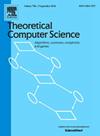Connectivity and diagnosability of the complete Josephus cube networks under h-extra fault-tolerant model
IF 0.9
4区 计算机科学
Q3 COMPUTER SCIENCE, THEORY & METHODS
引用次数: 0
Abstract
The h-extra connectivity and the h-extra diagnosability are key parameters for evaluating the reliability and fault-tolerance of the interconnection networks of the multiprocessor systems, and play an important role in designing and maintaining interconnection networks. Recently, various self-diagnostic models have emerged to assess the fault-tolerance in interconnection networks. These interconnection networks are typically expressed by a connected graph . For a non-complete graph G and , the h-extra cut signifies a vertex subset R of G, whose removal results in disconnected, with each remaining component containing at least vertices. And the h-extra connectivity of G is defined as the minimum cardinality of all h-extra cuts of G. The h-extra diagnosability for a graph G denotes the maximum number of detectable faulty vertices when focusing on these h-extra faulty sets only. The complete Josephus cube , a variant of , exhibits superior properties compared to hypercube , and also boasts higher connectivity. In this study, with the help of the exact value of the h-extra connectivity of , the explicit expression of h-extra diagnosability of under both the PMC model for and and the MM* model for and are identified to share the same value .
h-extra 容错模型下完整约瑟夫立方体网络的连通性和可诊断性
h-extra 连接性和 h-extra 可诊断性是评估多处理器系统互连网络可靠性和容错性的关键参数,在设计和维护互连网络中发挥着重要作用。最近,出现了各种自诊断模型来评估互连网络的容错性。这些互连网络通常由连通图 G(V,E) 表示。对于 h≥0 的非完整图 G,h-外切表示 G 的一个顶点子集 R,去除该子集后,G-R 断开,剩下的每个部分至少包含 h+1 个顶点。图 G 的 h-extra 连通性定义为 G 的所有 h-extra 切分的最小心数。图 G 的 h-extra 可诊断性表示只关注这些 h-extra 故障集时可检测到的最大故障顶点数。完整约瑟夫立方体 CJCn 是 Qn 的一种变体,与超立方体 Qn 相比具有更优越的特性,同时还拥有更高的连接性。在本研究中,借助 CJCn 的 h-extra 连接性的精确值,确定了在 n≥5 和 1≤h≤⌊n-32⌋ 的 PMC 模型以及 n≥5 和 2≤h≤⌊n-32⌋ 的 MM* 模型下,CJCn 的 h-extra 可诊断性的明确表达式具有相同的值(h+1)n-(h-12)+1。
本文章由计算机程序翻译,如有差异,请以英文原文为准。
求助全文
约1分钟内获得全文
求助全文
来源期刊

Theoretical Computer Science
工程技术-计算机:理论方法
CiteScore
2.60
自引率
18.20%
发文量
471
审稿时长
12.6 months
期刊介绍:
Theoretical Computer Science is mathematical and abstract in spirit, but it derives its motivation from practical and everyday computation. Its aim is to understand the nature of computation and, as a consequence of this understanding, provide more efficient methodologies. All papers introducing or studying mathematical, logic and formal concepts and methods are welcome, provided that their motivation is clearly drawn from the field of computing.
 求助内容:
求助内容: 应助结果提醒方式:
应助结果提醒方式:


